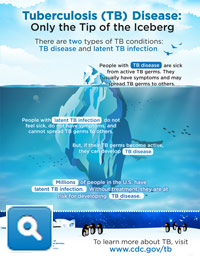|
WiRED International Observes World Tuberculosis Day
BY ALLISON KOZICHAROW AND BERNICE BORN
"U
nite to end TB” is the theme of 2016’s World Tuberculosis Day. On March 24 in 1882 Dr. Robert Koch announced his discovery of Mycobacterium tuberculosis, the bacillus that causes TB. The disease ranks alongside HIV/AIDS as the world’s top infectious disease killer.
WiRED International’s TB module describes the illness, causes, symptoms, diagnosis, treatment and severity, while stressing prevention. TB is a chronic, contagious bacterial infection which is spread through the lungs, although it can affect other organs in the body. TB is primarily an airborne disease, and only people with active TB can spread the disease to others through actions such as coughing and sneezing or even singing or laughing. Once diagnosed, it is usually successfully treated with a regimen of drugs taken over six months to two years.
 From Centers for Disease Control
From Centers for Disease Control
and Prevention
Many people believe that TB is a disease of the past, but it is still the leading killer of young adults worldwide, especially affecting the poorest and most marginalized populations of the world in countries such as Angola, Cambodia, India and China. The World Health Organization’s goal of eradicating TB by 2030 is challenged by TB’s growing resistance to antibiotic drugs.

Resources

United Nations Secretary-General Ban Ki-moon said, “Between 2000 and 2015, TB prevention, diagnosis and treatment saved 43 million lives. …This year alone, TB will affect more than 9.6 million men, women and children, and 1.5 million people will lose their lives. …Total victory over TB will require a united front. ”
Take a Sample Quiz from WiRED’s TB Module
^ Back to the Top |





